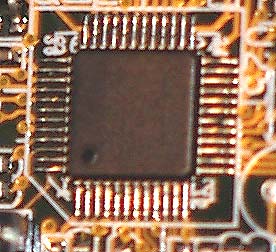Asus P4S800D-E Deluxe & Gigabyte 8S655TX Ultra: SiS 655TX Challenges Intel's Best
by Wesley Fink on December 9, 2003 1:52 PM EST- Posted in
- Motherboards
Asus P4S800D-E: Features and Board Layout
In addition to the feature set provided by the 655TX, Asus adds a number of additional features.
This is the first use of the SiS 180 RAID controller on a production motherboard. It appears that the 180 is ideally matched to extend the capabilities of the on-ship SATA of the 964 South Bridge. Asus provides up to 2 additional SATA ports plus another IDE port for up to 2 additional IDE drives. The four SATA and IDE devices can be configured as regular devices or as RAID 0, 1, 0+1, or JBOD (spanning, literally “just a bunch of drives”). The unified SiS 964/180 driver controls both the 964 and 180 drives, simplifying installation.

Gigabit LAN is provided by the Marvel chip; the first time we have seen Asus use this Ethernet chip.

In the continuing upgrades to on-board audio, Asus uses the high-quality Analog Devices SoundMax AD1888 codec to supply 6-channel audio. This is the same chip that Asus uses on all their upper end boards, and it is the chip pioneered by Intel on their top 875 boards along with the auto-jack-sensing feature. A Coaxial SPDIF out jack is provided on the rear panel for Dolby Digital setups. More information on the SoundMax audio codec is available at http://www.soundmax.com/.

I/O port offerings on the P4S800D-E are excellent. They include the PS2 ports, SPDIF out, Parallel, Serial, Firewire, 4 USB 2.0 ports, Gigabit LAN, and 3 mini jacks with auto-sensing for up to 6 external speakers. The auto-sensing feature is nice, but keep in mind that with 6 speakers connected, you will no longer have a MIC port available in this configuration.
Board Layout

The Asus P4S800D-E is full-size ATX design with plenty of room for an effective layout of the on-board options. The basic layout of the board is outstanding, with only 2 minor complaints.
First, although the 20-pin ATX connector is in our preferred upper right position, the 4-pin 12 volt connector is to the left of the CPU socket and near the midline of the board. This means that the 12-V cable must be snaked around the CPU and it is not the best location for most case designs. We probably have to go back to SiS with this complaint, since it seems to be carried over from the Reference board. The second item is the location of the on-board audio connectors. If you need to use an audio connector for your DVD/CD, the location at the lower left of the board will be a challenge for running cables. We generally prefer a location above the slots for the audio connectors — it makes it easier to route audio cables.
The IDE connectors, IDE RAID, and 4 SATA connectors are all in good locations. The edge-connector floppy is about midline and worked fine, but we usually like it a bit higher for tower cases that put the floppy at the top. All-in-all, there is a lot to like on this board layout, and not many complaints.

It is good to see that Asus is also using color-coded panel connectors. We first saw these on a Gigabyte board and they do make deciphering these connections a lot easier.










24 Comments
View All Comments
WhoBeDaPlaya - Friday, April 23, 2004 - link
LOL swt - wish I got paid for the reviews I write :Pswt - Saturday, February 7, 2004 - link
Having bought the P4S800E, I can correct a couple of misimpressions.First, the passive heatsink on the NB isn't so large as to interfere with my Zalman CNPS-7000Cu. Other mondo coolers might be problematic, of course.
And the AMI BIOS now supports multiple CPU Core settings, all the way up to 1.9V. Since I don't get paid to write such reviews, I'm not going to type in the details - but the BIOS that shipped with the MB *has* been updated in that regard, as promised.
buzzby311 - Tuesday, December 30, 2003 - link
buzzby311 - Tuesday, December 30, 2003 - link
All of the current memory reviews talk about memory that is great for the 865 875 chipsets. What memory would be good for overclocking on this motherboard with an Intel 3.0GHz 800FSB HT processor?Wesley Fink - Monday, December 15, 2003 - link
Asus says the P4S800D-E will appear on their web site on Friday, December 19, 2003. They expect the boards to be available for sale in the US by January 1.ColdRolledSteel - Thursday, December 11, 2003 - link
I also would like to know when the P4S800D-E is coming out. It isn't listed anywhere, including on the usa.asus.com website....Wesley Fink - Wednesday, December 10, 2003 - link
Spacecomber -We normally check FSB and report those that are out of spec. With these 3 boards all are within 0.5MHz of 200. The Asus P4S800D-E is 200.1, and both Gigabyte 8S655TX Ultra and Asus P4C800-E are at 200.5. If numbers are way off we correct them to 200 (800) before running benchmarks if possible.
Spacecomber - Wednesday, December 10, 2003 - link
Unless I missed it, did you check to make sure no one was cheating a bit with their front side bus speed? Is a 200 MHz frontside bus really a 200 MHz frontside bus for all three boards that you compared?Thx
Space
Wesley Fink - Wednesday, December 10, 2003 - link
#14 - All our Benchmark tests on the 655TX boards were done with an ATI 9800 PRO with Fast Writes enabled, so there does not not seem to be a general problem with ATI cards.valnar - Wednesday, December 10, 2003 - link
#3Why would I want to give up that?